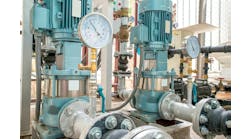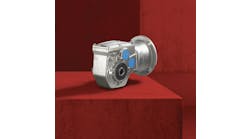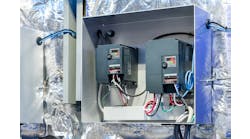Can you talk about the pluses and minuses of using a soft starter or an ac variable-frequency drive (VFD), as well as explaining the applications in which one might be a better fit than the other?
Greg Maryniarczyk, test engineer at DLS Electronic Systems:
Soft-start drives are used to limit inrush current associated with electric motor startup. Soft-start drives lower the initial voltage by adding solid-state series impedance and ramp up until full speed is achieved. Doing this extends the life of the motor and mechanical components that are connected to it. Large motor electric inrush current also places a high demand on the electrical supply system, which often results in extra cost.
VFDs deliver much higher frequency source power during startup to reduce current due to the increased inductive impedance. This can be advantageous if control is desired after full speed is reached. This control allows for continuing control as the load on the motor is changing. VFDs are more efficient and produce less heat, while being able to start motors under considerable loads. In both methods, as the motor reaches operating speeds, the counter electromotive force (CEMF) increases to limit current to steady-state conditions.
Margie Rawlins, lead control systems engineer at Thermo Systems, a Control System Integrators Association (CSIA) member: The main deciding factor between using a VFD or a motor starter is the ability to continuously change the speed of a motor. If your application is going to be a set speed, then you should use a motor starter. They are generally much lower in cost and easier to setup. If you are going to need or want to be able to match the speed of other machines, or have the flexibility to continually ensure optimal machine operation, then a VFD is the way to go.
With a VFD, you can receive feedback using many types of communications, from hardwired I/O points, if you just want minimum feedback, to Ethernet, if you want to have all the data in the drive available to your controller.
With a motor starter, you can still get feedback. Devices such as Allen Bradley’s E3 electronic overload relays can give you feedback on how your device is running—current, torque, leg voltages—without having the added cost and setup of a VFD. These devices can also be set up with hardwired I/O or over communication protocols such as DeviceNet and ControlNet.
VFDs offer more options on how you can fine-tune your process and flow to optimize your facility or product. You also have considerably more feedback available to you, if that is what you desire.
VFDs provide all of these benefits and more, including power-factor correction and low power consumption, along with full-speed control and not just start/stop control, but the additional cost of the VFD must be justified. Other benefits include dynamic braking, PID control, Safe Torque Off (STO), built-in I/O and logic, fire mode, circulatory control mode, multi-motor control, communication interfaces and network control. The list goes on and on, depending on model and manufacturer.
Daniel Weiss, senior product manager at Newark element14: In today’s competitive landscape of energy management, soft starters provide a valuable alternative to across-the-line motor starting.
A soft starter helps to protect the motor and connected equipment from damage by controlling the voltage supplied to the motor. This limits the initial inrush of current, extending the life of the motor, and reduces mechanical shock sustained during starting by providing a more gradual ramp-up to full speed.
Soft starters are also applicable where electrical systems have limited current capacity. When using a soft starter, inrush current is more limited than conventional across-the-line motor starting. By gradually increasing the voltage at the motor terminals, the soft starter produces a more regulated motor acceleration up to full speed. Soft starters are also capable of providing a gradual ramp to stop, where sudden stopping may create problems in the connected equipment.
Check out soft starters for applications where speed ramping and torque control are desired for starting or stopping; where supply network issues or penalty charges may occur while starting a large motor—high inrush current; where a gradual controlled starting is required to avoid shock and tension in the mechanical system for applications such as conveyors, belt-driven systems, gears and couplings; and where pressure surges or water hammer may occur in piping systems.
Steve Perreault, industrial drive product management at Yaskawa: Both soft starters and VFDs dramatically reduce starting current and potentially damaging levels of starting torque. Soft starters are often the most economical choice when considering only the starting condition. And, after the starting event, the motor receives sinusoidal voltage, with zero added distortion. Although there are methods for minimally controlling speed with a soft starter, doing so is very inefficient and inaccurate.
The cost of VFDs has decreased dramatically in recent years, and the benefits over soft starters are numerous. The main disadvantages of VFDs compared to soft starters, are that, first, VFDs introduce a small amount of extra heat in the motor—imperfect sine wave—and, second, VFDs draw nonlinear current, known as harmonic distortion, from the power source.
In most cases, the benefits of VFDs greatly offset these things, and special VFD countermeasures exist to greatly reduce them when necessary. Not only do VFDs provide an extremely smooth and controlled start, but they also efficiently control motors to nearly any desired level of speed, torque or position, including over-speed and full torque at zero speed.
Special application and safety features are often included, providing even greater benefit. In most cases, variable-speed control greatly improves processes and yields impressive energy savings.
Chuck Fernandez, enclosed low voltage product manager at Siemens: Obviously, the reduced-voltage soft starter (RVSS) cannot be run at different speeds like a variable-speed drive (VSD). If you have an application where the motor will run at full speed all the time, then an RVSS is much smaller and less expensive than a VFD. But in many applications, there is a need to vary flow or pressure.
With an RVSS, this is usually done by running the motor at full speed and then using a control valve to change flow or pressure. Using a VFD, the need for a control valve is eliminated since we just vary the speed of the motor to adjust flow or pressure.
By not running the motor at full speed, we know from the affinity laws that the VFD method drastically lowers the energy used. With many applications, the control valve can be expensive to maintain due to the need to constantly clean or unclog the control valve. This is all eliminated using the VFD.
Both the reduced-voltage soft starter and the variable-speed drive can ramp up the motor to eliminate harmful mechanical impacts of across-the-line starting.
The soft starter does switch over to running across the line, so it will be a linear load while running across the line. This means it will not inject harmful harmonic distortion into your plant’s ac power grid. The VFD is a nonlinear load and, therefore, does inject harmonics into your power grid.
For most environments or locations, this isn’t an issue. In areas that require low harmonic content, as defined by IEEE519, there are drives that have this functionality integrated as hardware, so there’s nothing to set up, maintain or adjust. The extra cost of these “clean power” drives is far less than the energy savings gained through the variable-speed operation of pumps, fans and compressors mentioned.
Tim Albers, director of marketing and product management at Nidec Motor: An ac variable-frequency drive can do everything a soft starter can do and more. The soft starter can only soft-start. There are different types of soft starters, but the most common controls the voltage and therefore the current of the motor as it starts to limit the inrush of current.
Based on that limitation, the motor will also start slower. The advantages of that are a cooler rotor at start and a slower or softer starting process on both the installed electrical power-supply system and the mechanical structure of whatever equipment is being started.
A variable frequency drive can do the exact same things. The advantage of the variable -frequency drive is that it can do so much more after the motor is accelerated and up to speed.
To be honest, soft starters have reached an economic cost point versus variable frequency drives so that, now, below 25-75 hp or so, the cost of a soft starter is not necessarily lower than the cost of a variable frequency drive.
The larger the load, the more cost advantage that a soft starter has, particularly for medium voltage. For an extreme example, the market price of a 25-hp soft starter and a variable-frequency drive are very comparable. For a medium-voltage 4,000-hp, the soft starter may be as little as 33% to 40% the cost of a variable-frequency drive. In that case, it is not application-dependent, but, instead, power- and voltage-dependent.
In my opinion, the only advantage of a soft starter over a VFD is cost. If process matching of the speed of the process to a variable process output is not required, then price should be the only determining factor. If the process can be optimized or cost saved on electricity by matching the process speed, then a VFD will always be the choice.
Jared Orlicki, engineering technician at Fuji Electric of America: Soft starters and VFDs can both be used to control accelerate and decelerate ac motors, reducing the starting current. VFDs provide the additional advantage of controlling the output frequency, while soft starters are fixed at line frequency operation. The VFD’s variable-speed operation is referred to as variable voltage variable frequency (VVVF).
Soft starters utilize silicon controlled rectifiers (SCRs) to perform phase angle control, while VFDs use insulated-gate bipolar transistors (IGBTs) to perform pulse-width-modulation (PWM) control.
The advantages of the soft-starter design are lower Watt loss, no harmonics except during acceleration/deceleration, less maintenance and lower initial cost. However, there are numerous advantages provided by the VFDs’ variable-speed capability. VFDs are better-suited for advanced applications that require speed control, torque control, PID control and dancer control.
VFD technology continues to evolve, while soft starters are considered a mature product by most engineers. Each new generation of VFDs provide higher performance, smaller size and more advanced CPU control. VFDs enable the advanced motor control that is required by many applications and can deliver operational cost savings in many others. Soft starters are only considered suitable for simple fixed-speed applications.
Nisha Chandrasekharan, portfolio manager for low-voltage drives at Rockwell Automation: The primary advantages of soft starters are twofold—generally lower purchase price compared to a VFD; and the ability to bypass the power electronics in the soft starter once the motor is up to full speed and operating.
A VFD’s power electronics always operate when the motor is operating. The soft starter’s bypass will offer slightly lower losses, and therefore energy, when the motor simply needs to run at full speed all the time. The advantage of a soft starter over a standard contactor to start a motor is reduced demand on the electrical system during the starting of a motor.
A typical low-voltage motor will require six to seven times its rated current during starting. The soft starter can typically reduce those requirements to two-and-a-half to four times the motor-rated current during motor startup. Benefits of the reduction of inrush current to the motor include lower torsional shock to the rotating system—motor, coupling and rotating load—during startup, lower peak current to motor, lowering the overall kVA demand on the electrical system during startup and lower voltage dip—light flicker—that can occur when starting larger motor loads.
VFDs offer several advantages over soft starters that can be substantial—speed control of the motor and application; energy savings; lower inrush current; and the option of full torque or higher for starting the motor.
VFDs also offer the ability to supply real-time process information and preventive and predictive maintenance information back to the control system.
VFD speed control allows users to match process operation and output to changing demands for products. Substantial energy reduction is typical for pumps and fans. In those applications, power demand drops off as a cubic function of speed where a 10% reduction in speed relates to an approximate 33% reduction in energy usage.
Many users believe their pump just needs to run at full speed as the process can handle excess flow easily or there is a control valve in place already. Using a drive allows users to turn back the pump to actual required flow or match the required flow to the process.
Users can also apply a VFD with the control valve set to wide open and use the drive to set required flow at less than system design, saving substantial amounts of energy.
An additional benefit of VFDs is reduced valve and pump maintenance costs. Control valves and pumps are hardest pressed in service when operating at full speed or high pressures, and VFDs can help to reduce that pressure and the resulting maintenance needs. Some applications of VFDs can eliminate the control valve altogether.
Finally, some drives can act as a power converter. In some applications, VFDs can be operated with single-phase input power to operate a three-phase motor. Sizing of the VFD should be carefully considered for these kinds of applications.
Common applications for soft starters include applications with low or medium starting torque; lightly loaded applications; little or no speed control during run mode; control of inrush; and power monitoring.
Common applications for drives include single-phase applications; speed control and system efficiencies operating at reduced speeds during the run mode; applications with high starting torque; continuous feedback for critical position control; and holding motor at zero speed.
Load types for which a soft starter would not be recommended include extruders, positive displacement pumps, inclined conveyors, lifts and nonhydraulic elevators. Full torque is not available at zero speed or very low speeds with soft starters. However, an ac drive can produce rated torque from zero to rated speed and can typically handle all load types.
Soft starters are meant to reduce the power surge that occurs when you power on a motor across the line. Utility companies have demand charges or fees based on your peak power demand. It behooves the user to eliminate their peak demands as much as possible.
Therefore, a soft starter can be used to reduce the utility company’s demand charge. More advanced soft starters provide a form of motor-overload protection.
The operation of motor/application will dictate if the user can overcome the added cost of a VFD compared to a simple soft starter. If the motor will never operate at a different speed than line speed, say, 60 Hz, then the most economical choice is likely a soft starter. However, if the application will deviate in any way from rated power operation at line speed, then a VFD is the correct solution.
Deviation from rated line power operation is done in two ways. First, the application reduces motor speed through gearboxes, pulleys and variable sheaves. Secondly, the motor load can be reduced. For example, adding vanes to the outlet of a fan will reduce motor torque demand and result in reduced power operation.
The system demand requirements for reduced speed and/or flow adjustments through mechanical means can be efficiently accomplished through the use of a VFD. Using a VFD to operate a motor below base speed versus mechanical means will provide, at a minimum, motor-overload protection, isolation from the line, increased power factor and improved efficiency throughout the motor's operational range.
Some problems with this type of start are that the high inrush current and peak starting torque can lead to mechanical slipping, heavy wear and tear and problems with the process or damage to the product.
Many applications can benefit from a soft start to help to avoid these problems. A soft starter is a good choice for applications that only need to run at full speed but would also benefit from the provided reduction of electrical and mechanical stresses.
Applications that require running at a reduced or variable speed are better suited to variable-frequency drives. VFDs provide better control of the application than other methods. They make precise start or stop ramp times possible, while being able to control the speed and even having the capability for reversing the motor at full speed.
Drives are particularly well-suited for applications that require braking capacity since they have the capability of converting braking energy into heat by using a chopper that drops excess regenerative voltage across a resistor.
RVSS is a lower customer cost and is generally much smaller and simpler. RVSS can, and often is, bypassed after the ramp-up, so the motor is direct on line. This is hard to do for a VFD without a bump since the drive won’t be in phase with the line usually. Of course, an RVSS cannot do any kind of speed control, only torque to a limited degree; it’s a one-trick pony that ramps up voltage to the line level, and that’s it.
The negatives for VFDs: Motors three to five years ago were not always inverter-duty-rated, and cables could have the same issue. Pay special attention to the motor insulation class and confirm a customer is using an inverter-duty-rated motor and appropriate cables to ensure that there are no premature failures due to issues caused by PWM waveforms induced into the motor and cables. Some of the key VFD key disadvantages are with older motors; when operating at 480 V as opposed to 230 V; and where there are long cable runs between the VFD or RVSS and the motor, 40 to 50 feet or longer.
With open-loop V/Hz control, offered by very basic VFDs, 3% accuracy is achievable, whereas with open-loop vector control, 0.3% accuracy is achievable, and, by adding an encoder to the shaft, 0.01% accuracy can be achieved in closed-loop vector control. This also adds the ability to hold 100% load at stall.
Many applications can also benefit from soft starting the mechanics. Both VFDs and soft starters can achieve this, but modern VFDs can also offer energy savings, resulting in real dollars for the user.
A common conveyor application requires full power when the conveyor is started or accelerating or when shock-loaded, and when running at a steady state the energy needs to drop significantly. Many modern VFDs can incorporate an ECO mode to sense the drop in motor loading and appropriately drop the voltage applied to the motor to achieve energy savings while in this state.
Finally, applications can benefit that are governed by the affinity laws. Those applications can achieve substantial energy savings by using a VFD. Such applications include centrifugal fans and pumps, where the power required for an application progresses as a cube function in relation to the speed. Fans and pumps are typically sized for their max duty points, but rarely do they actually need to run at these loads.
In applications without a VFD, the motor is run at full speed and either guide vanes, throttle valves or bypasses reduce the fluid to the duty point. While this does provide a small degree of energy conservation, by directly reducing the voltage applied to the motor the VFD can take full advantage of the inherent energy savings.
In simple numbers, a fan run at half-speed may only draw one-eighth the power required at full speed. Therefore, VFDs can pay for themselves quite quickly.
Soft-start devices are also fairly simple, consisting of three SCR pairs, two for each power phase, support circuitry for phase angle control and possibly bypass contactors. Their cost is typically lower at most power levels than a full-blown variable-frequency drive. Not having to convert ac power to dc and then convert it back to three-phase power like true VFDs, soft starts can achieve higher levels of efficiency, typically 99.5% to 99.9% when a motor is run at full speed. Most VFD efficiency levels are in the 95% to 98% range.
Variable frequency drives, on the other hand, are great for applications that require higher starting torque and where variable-speed control is desired. VFDs have come a long way from being simple shaft turners. They are now high-performance devices that can provide high accuracy speed, position and torque control.
Advanced microprocessors have allowed VFDs to continuously improve in performance. Being able to manage the frequency and voltage going to a motor allows for much better control of motor characteristics than a simple soft start.
Another capability that some VFDs have is the ability to run three-phase motors when only single-phase power is available. This is due to the fact that VFDs already have an internal filter circuit that takes single- or three-phase power and converts it to dc before converting it back to ac power for the motor.
Some VFDs can double the incoming power and run 230 Vac three-phase motors when only simple-phase 115 ac is available.
Typically, solid-state soft starters, consisting of two thyristors, connected in inverse parallel with one controlling the positive and one the negative half-wave of the input power, are applied when the line is still fairly robust or stiff.
The soft start allows the root mean square (rms) value of the motor voltage to increase from an adjustable starting voltage or starting torque to the rated motor voltage, but the starting torque is reduced quadratically in relation to the voltage applied to the motor.
Consequently, the torque available is dramatically reduced. A 50% reduction in voltage reduces the current inrush by 50% but reduces the torque available for acceleration to 25%. Typically, the solid-state starters are limited to about 250% to 300% inrush, so there is still some potential voltage sag, and the motor must be checked to ensure that enough torque is developed to accelerate the motor to full speed and not stall at some point along the starting load curve.
The soft starter does not change line frequency, just the voltage applied to the motor terminals. The soft-start approach is fairly flexible in that the initial voltage and ramp time can be controlled and a maximum current draw can be selected. These settings can easily be modified in the field.
Generally, the soft-start system is cost-effective but has the disadvantage that it cannot produce the torque-per-line side Amp ratio compared to an across-the-line autotransformer or variable frequency drive.
A VFD is applied when the power line is soft and cannot tolerate even a reduced voltage start, and the current inrush must be limited to the full load rating of the motor. Using a VFD, the motor acceleration is controlled by ramping up frequency, and the voltage at the motor terminals is directly proportional to the frequency supplied by the VFD.
High starting current is eliminated due to the motor being up to speed at the reduced frequencies. The VFD provides the highest torque per Amp ratio of any starting method.
The motor can be controlled to accelerate at rated full load current. And, by controlling the rate of frequency increase, the Amp draw can be reduced to the level required to produce the brake horsepower (bhp) required by the load at reduced frequency.
The driven equipment does not need to be unloaded and can be run at reduced speed during periods of decreased demand. However, the disadvantages of the VFD are increased cost and the effect of drive harmonics on the power system, and some drives may require upgraded motor insulation and/or insulation of both bearings.
The higher cost of the VFD is still much lower than increasing the power available from a utility and is much easier to apply in that the motor is able to produce rated torque through the entire acceleration time.





















